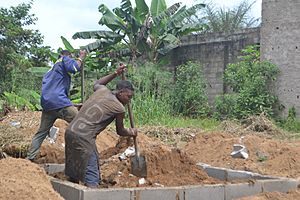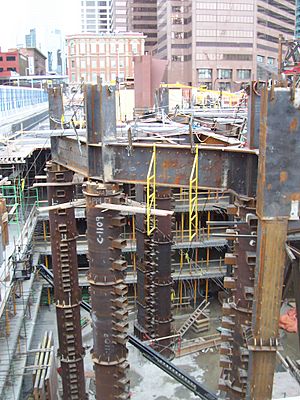Foundation (engineering) facts for kids

Have you ever wondered how huge buildings like skyscrapers stay standing? It's all thanks to something called a foundation! A foundation is the very bottom part of any building. Think of it like the roots of a tree, but for a house or a tall tower. It's hidden underground, but it's super important.
Every building needs a strong foundation. This is especially true if the building is very heavy or if the ground it sits on is soft. A good foundation makes sure the building stays safe and doesn't sink or fall over.
Contents
Building a Strong Foundation
Digging Deep
To build a foundation, engineers first dig a big hole or a long ditch, called a trench, in the ground. They keep digging until they reach solid, stable ground. This solid ground is important because it can hold the weight of the building. The deeper and heavier the building, the deeper the foundation usually needs to be.
Filling the Trench
Once the trench is deep enough, it's filled with strong, hard material. Often, a special mix called concrete is used. Concrete is like a super-strong liquid rock that hardens over time. It's made from cement, water, sand, and gravel.
Sometimes, to make the concrete even stronger, long, thin pieces of steel are placed inside the trench before the concrete is poured. When the concrete dries, the steel acts like a skeleton, holding everything together. This super-strong combination is called reinforced concrete. It's used for many big buildings and bridges.
Ready for Construction
After the foundation material has been packed down tightly, or the concrete has dried hard, it's ready! This solid base can now support the rest of the building. Then, the exciting part begins: the main construction of the building can start rising above the ground.
Types of Foundations
Foundations come in different types, depending on the building and the ground.
Shallow Foundations
Shallow foundations are used for most homes and smaller buildings. They don't go very deep into the ground.
- Slab-on-grade: This is a single, thick concrete slab that sits directly on the ground. It's common in places with warm climates.
- Crawl space: This type lifts the house a little off the ground, creating a small space underneath. It's good for plumbing and electrical work.
- Basement: A basement is a full story built underground. It provides extra living space and a very strong foundation.
Deep Foundations
Deep foundations are needed for very tall or heavy buildings, like skyscrapers, or when the ground near the surface is too soft.
- Piles: These are long, strong columns, often made of concrete or steel, that are driven deep into the ground. They act like stilts, reaching down to very strong soil or rock.
- Caissons: Similar to piles, but they are larger diameter shafts that are dug out and then filled with concrete. Workers can sometimes go inside them to dig.
The type of foundation chosen depends on many things, like the weight of the building, the type of soil, and even how much water is in the ground. Engineers study these things carefully to make sure the foundation is perfect for the job!
Images for kids
-
Shallow foundations of a house versus the deep foundations of a skyscraper.
-
Drawing of Poteaux-en-Terre post in ground type of wall construction (this example technically called pallisade construction) in the Beauvais House in Ste Genevieve, Missouri
-
PSM V24 D321 A primitive stilt house in Switzerland on wood pilings.
See also
 In Spanish: Cimentación para niños
In Spanish: Cimentación para niños












